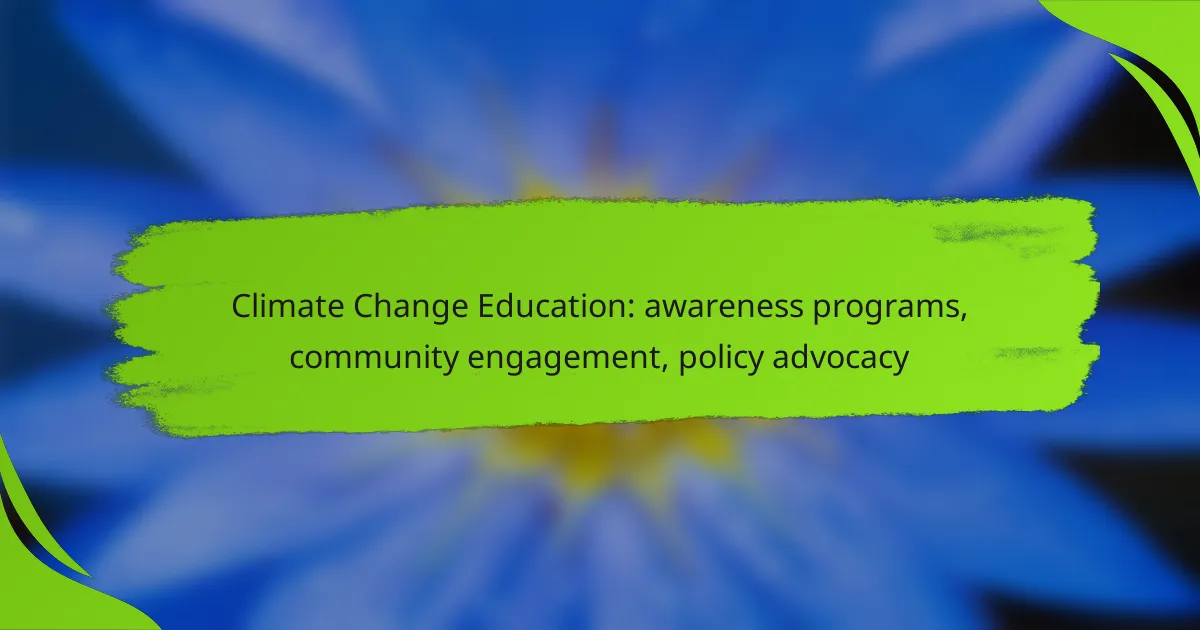Climate change education plays a vital role in fostering awareness and driving community engagement through collaborative initiatives. By involving schools, non-profits, and local governments, these programs aim to deepen understanding of climate issues and promote sustainable practices. Additionally, policy advocacy is essential in shaping regulations that support these educational efforts, ensuring that climate education remains a priority in public discourse.
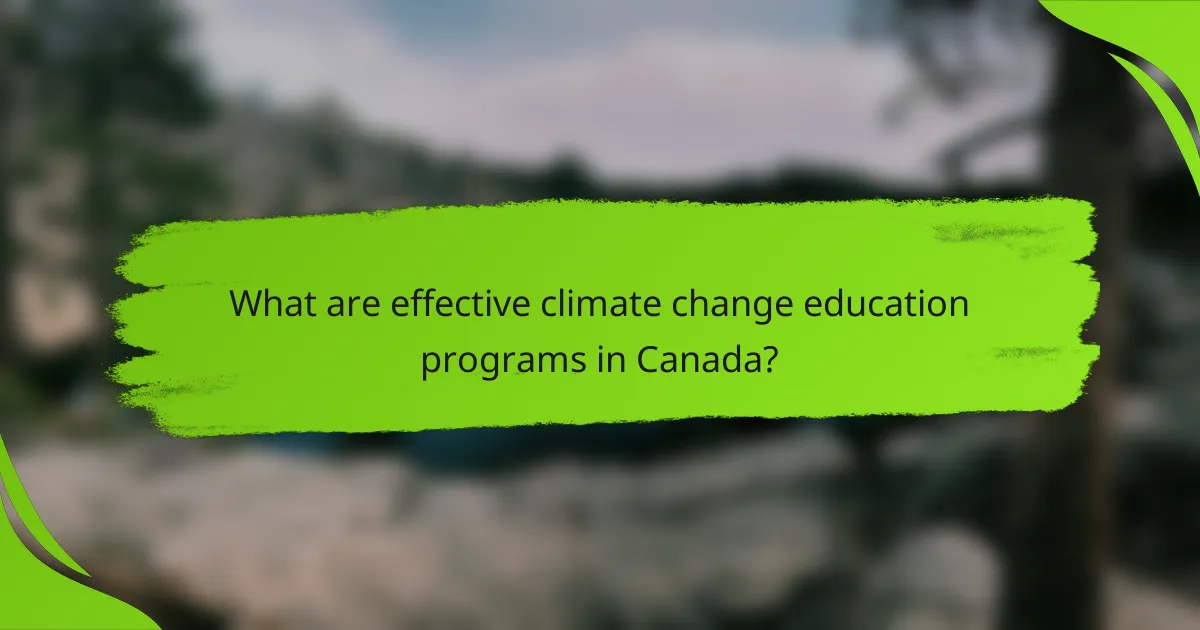
What are effective climate change education programs in Canada?
Effective climate change education programs in Canada focus on engaging communities, promoting awareness, and advocating for policy changes. These programs often involve schools, non-profits, and local governments working together to foster a deeper understanding of climate issues and encourage sustainable practices.
EcoSchools program
The EcoSchools program is designed to help schools in Canada implement environmental practices and educate students about sustainability. Participating schools can achieve certification by meeting specific criteria related to energy conservation, waste reduction, and biodiversity.
Schools engage students through hands-on activities, such as creating school gardens or conducting energy audits. This program not only raises awareness but also empowers students to take action in their communities, fostering a sense of responsibility towards the environment.
Climate Action Network initiatives
The Climate Action Network (CAN) coordinates various initiatives aimed at raising awareness and advocating for climate policies across Canada. These initiatives often involve grassroots campaigns, workshops, and public events that engage citizens in discussions about climate change and its impacts.
Through collaboration with local organizations, CAN promotes community-driven solutions and encourages individuals to participate in climate advocacy. This approach helps build a network of informed citizens who can influence policy decisions at local and national levels.
Green Learning resources
Green Learning provides a wealth of educational resources focused on climate change and sustainability for educators and students. Their materials include lesson plans, interactive activities, and multimedia resources that are aligned with Canadian curriculum standards.
By utilizing these resources, teachers can effectively integrate climate education into their classrooms, helping students understand the science behind climate change and the importance of taking action. Green Learning also offers professional development opportunities for educators to enhance their teaching strategies in this critical area.

How can communities engage in climate change education?
Communities can engage in climate change education through various initiatives that promote awareness, participation, and advocacy. These efforts often involve workshops, local groups, and collaborative projects that empower residents to take action against climate change.
Community workshops
Community workshops serve as interactive platforms where residents can learn about climate change impacts and solutions. These sessions typically cover topics such as renewable energy, sustainable practices, and local environmental issues.
To organize effective workshops, consider partnering with local environmental organizations or educational institutions. Aim for a mix of presentations, hands-on activities, and discussions to cater to different learning styles.
Common pitfalls include scheduling conflicts and low attendance. To mitigate this, promote workshops through social media, local newsletters, and community boards to maximize outreach.
Local climate action groups
Local climate action groups are essential for fostering community engagement and advocacy. These groups often focus on specific initiatives, such as reducing carbon footprints, promoting recycling, or advocating for policy changes at the municipal level.
Joining or forming a local group can provide individuals with a sense of community and shared purpose. Members can collaborate on projects, participate in campaigns, and organize events that raise awareness about climate issues.
To ensure effectiveness, groups should establish clear goals and regularly assess their impact. Engaging with local government and other stakeholders can enhance their influence and help drive meaningful change in climate policy.
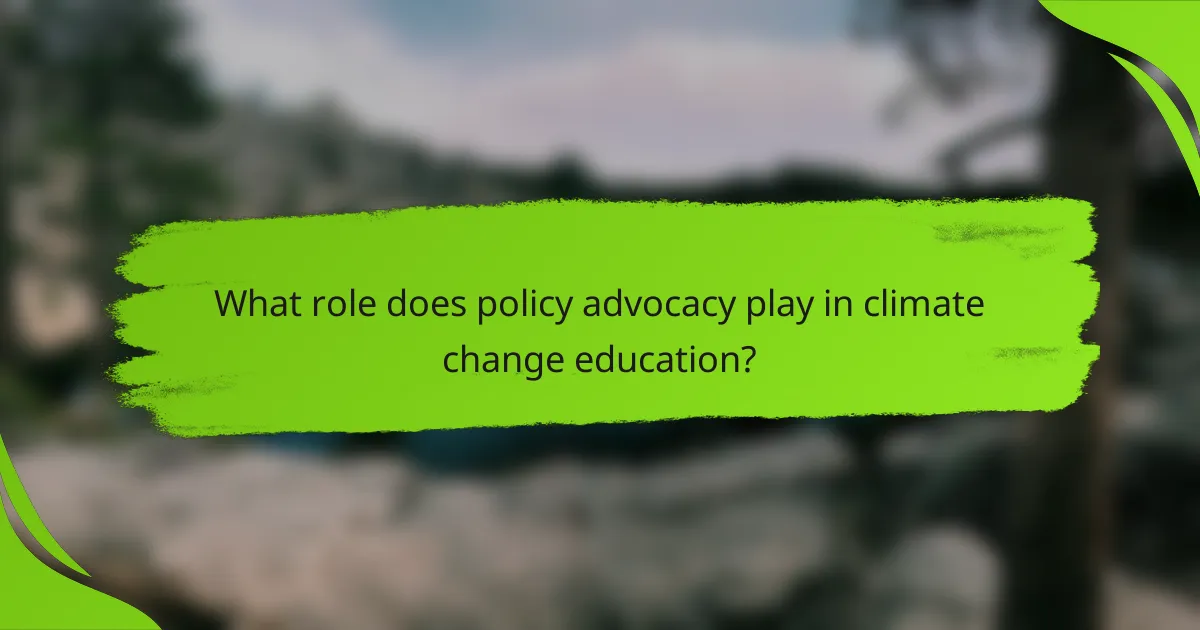
What role does policy advocacy play in climate change education?
Policy advocacy is crucial in climate change education as it shapes regulations and funding that support awareness programs and community engagement. By influencing decision-makers, advocates can ensure that climate education is prioritized and integrated into public policy.
Influencing local government policies
Influencing local government policies involves engaging with elected officials to promote climate education initiatives. Advocates can present data on the benefits of climate literacy, such as improved community resilience and economic opportunities, to persuade policymakers to allocate resources for educational programs.
Effective strategies include organizing community forums, providing policy briefs, and collaborating with local schools to demonstrate the demand for climate education. Building relationships with local leaders can enhance the chances of successful policy changes.
Collaborating with NGOs
Collaborating with non-governmental organizations (NGOs) can amplify the impact of climate change education efforts. NGOs often have established networks and expertise in advocacy, making them valuable partners in promoting educational initiatives.
Joint efforts can include co-hosting workshops, developing educational materials, and conducting outreach campaigns. By pooling resources and knowledge, both NGOs and advocates can create more comprehensive and effective climate education programs that resonate with diverse communities.
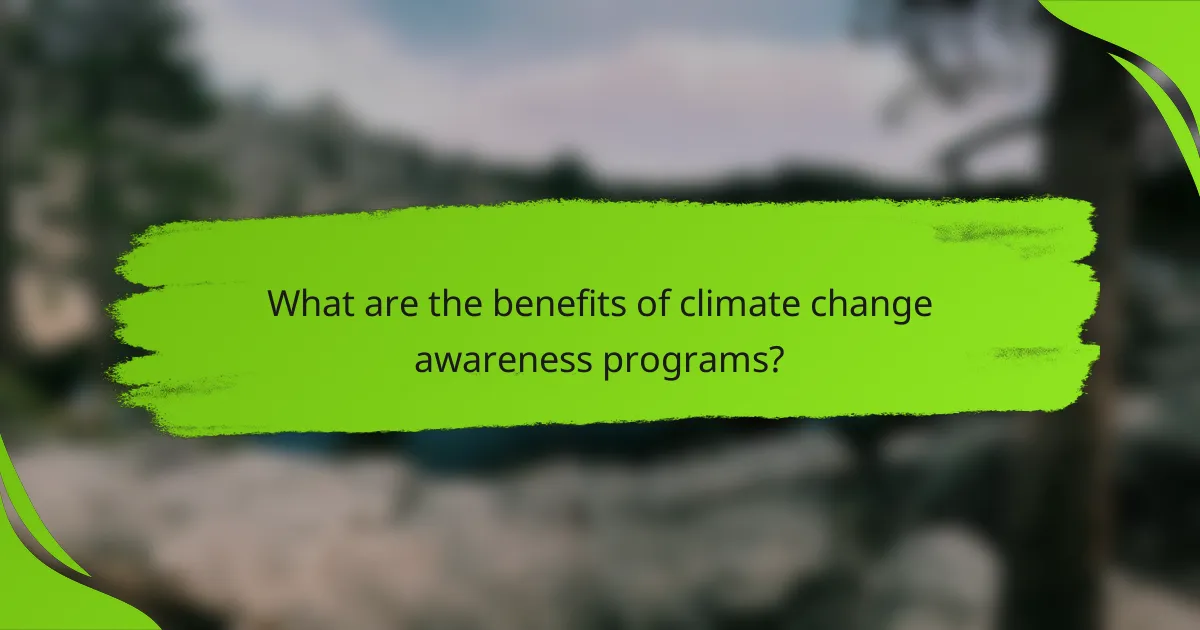
What are the benefits of climate change awareness programs?
Climate change awareness programs offer numerous benefits, including improved public understanding of environmental issues and increased community engagement in sustainability efforts. These programs empower individuals to take informed actions and advocate for policies that mitigate climate change impacts.
Increased public knowledge
Awareness programs significantly enhance public knowledge about climate change, its causes, and its effects. By providing accessible information, these initiatives help individuals understand complex scientific concepts and the urgency of the climate crisis.
Workshops, seminars, and online resources can effectively educate the community. For example, local governments may host informational sessions that cover topics like carbon footprints, renewable energy options, and sustainable practices that can be easily adopted at home.
Enhanced community resilience
Climate change awareness programs foster enhanced community resilience by encouraging collective action and preparedness. When communities are informed about potential climate impacts, they can develop strategies to adapt and mitigate risks, such as flooding or extreme weather events.
Engagement in local initiatives, such as tree planting or community gardens, not only strengthens social ties but also contributes to environmental health. Communities that actively participate in resilience-building activities are better equipped to respond to climate-related challenges, reducing vulnerability and promoting sustainability.
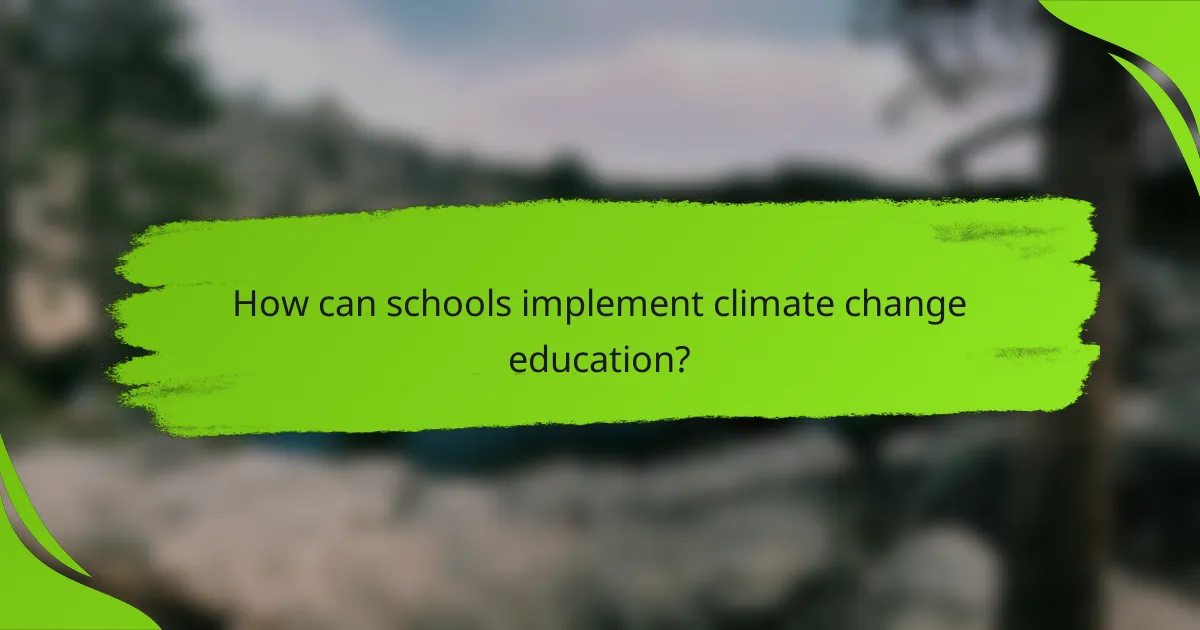
How can schools implement climate change education?
Schools can implement climate change education by integrating relevant topics into their curriculum and promoting engagement through extracurricular activities. This approach not only raises awareness but also empowers students to take action on climate issues.
Curriculum integration
Integrating climate change topics into existing subjects, such as science, geography, and social studies, helps students understand the multifaceted nature of the issue. For instance, science classes can cover the greenhouse effect, while geography lessons can explore the impact of climate change on different regions.
To effectively integrate climate change education, educators should align lessons with national or local educational standards. This ensures that the content is relevant and meets the required learning outcomes. Schools can also utilize resources from environmental organizations to enhance lesson plans.
Extracurricular activities
Extracurricular activities provide additional avenues for students to engage with climate change education outside the classroom. Schools can establish eco-clubs, organize tree planting events, or host workshops on sustainability practices. These activities foster teamwork and encourage students to apply their knowledge in real-world contexts.
Additionally, schools should consider partnerships with local environmental groups to enhance these programs. Collaborating with community organizations can provide students with hands-on experiences and access to expert knowledge, making the learning experience more impactful.

What are the challenges in climate change education?
Challenges in climate change education include insufficient funding, resistance to change, and the need for effective community engagement. These obstacles hinder the implementation of awareness programs and policy advocacy efforts aimed at addressing climate issues.
Lack of funding
Insufficient funding is a significant barrier to effective climate change education. Without adequate financial resources, programs struggle to develop materials, conduct outreach, and implement initiatives that raise awareness in communities.
Funding can come from various sources, including government grants, private donations, and partnerships with organizations. However, competition for these funds is high, and many programs may not receive the necessary support to thrive.
To overcome this challenge, educators and advocates should explore diverse funding opportunities and collaborate with local businesses and nonprofits to secure resources for climate education initiatives.
Resistance to change
Resistance to change poses a major challenge in climate change education, as individuals and communities may be reluctant to alter established behaviors or beliefs. This resistance can stem from misinformation, cultural values, or a lack of understanding about climate issues.
To effectively address this resistance, educators should focus on building trust and fostering open dialogue. Engaging community leaders and influencers can help bridge gaps and encourage acceptance of new ideas related to climate action.
Utilizing relatable examples and local case studies can also help demonstrate the benefits of change, making it easier for individuals to embrace new practices that contribute to climate resilience.

How can technology enhance climate change education?
Technology can significantly enhance climate change education by providing innovative tools and platforms that facilitate learning and engagement. These advancements allow for interactive experiences and broader access to information, making it easier for individuals and communities to understand climate issues and take action.
Online learning platforms
Online learning platforms offer accessible and flexible options for climate change education. They provide a range of courses, webinars, and resources that can be tailored to different audiences, from students to professionals. Popular platforms like Coursera and edX often collaborate with universities and organizations to deliver high-quality content on climate science and sustainability.
When choosing an online platform, consider factors such as course accreditation, user reviews, and the availability of interactive elements like quizzes and discussion forums. These features can enhance engagement and retention of information. Additionally, many platforms offer free or low-cost options, making education more accessible.
Interactive simulations
Interactive simulations are powerful tools that allow users to visualize the impacts of climate change and explore potential solutions. These simulations can model scenarios such as rising sea levels, temperature changes, and the effects of various mitigation strategies. By engaging with these models, learners can better grasp complex concepts and the urgency of climate action.
For effective use of simulations, look for platforms that provide user-friendly interfaces and clear instructions. Some simulations may require specific software or hardware, so ensure compatibility with your devices. Incorporating these tools into educational programs can foster critical thinking and problem-solving skills among participants.
